Last November, my girlfriend and I took a trip to Denmark and visited the Viking Ship Museum in Roskilde. That was a great trip, and the ship museum was pretty great, but there were a couple things that we wanted to do, but which we couldn't because the ship museum doesn't operate them in the winter. For one thing, the museum has a collection of reconstructed Viking ships, including a full-size longship. These ships are usually docked in the harbor, along with some living exhibits of the construction and maintenance of these ships and the ropes and sails used to sail them. During winter, the exhibits are closed and the ships themselves are brought onto land and covered in order to prevent ice from forming and damaging the ships.
More importantly, the museum offers tourists the opportunity to go out sailing the reconstructed ships with a couple of museum guides. This service is also only offered in the summer due to weather restrictions, and we decided that we wanted to go back to Denmark so that we could sail a Viking ship!

Big Ben was the first of several Civilization
world wonders that I'd get to see.
She found affordable tickets to London, and we allocated two weeks to spend in Europe this summer. My dad also expressed an interest, and we offered to take him with us and pay for part of his airfare and lodging expenses as a combined Father's Day and birthday gift (his birthday is in May). We ended up deciding to take him to London, England, to Coppenhagen, Denmark, and to Munich, Germany.
London, Stonehenge, and Shakespeare
Our first stop was London, England on June 26th. We did some of the usual tourist things, like visit the Tower of London and walk by Parliament and Big Ben (one of several Civilization wonders that I would be visiting during this trip!) and Westminster Abbey. We also had fish, chips, and beer in a pub and started two week's worth of gluttonous eating! Despite walking 15 to 20 miles per day, I still gained 3 1/2 pounds during the trip.
The British Parlaiment building was covered with scaffolding, apparently being repaired or remodeled. This would actually become a recurring theme during this trip, as many of the places that we visited would be covered with scaffolding.
We visited the Imperial War Museum, including the Churchill Warroom.
I tried on some World War I-era clothing, which was very uncomfortable and itchy.
The second day (Tuesday), we visited the Churchill Warroom and the Imperial War Museum. I had previously visited the Imperial War Museum in Manchester during my trip to the U.K., so this time we got to see the larger museum in London. I was a little bit disappointed that the museum didn't cover British Imperial history prior to World War I. There were no exhibits about colonial British sailing ships. The museum starts with World War I, and then goes through World War II, the Cold War, and the War on Terrorism. It also included an exhibit on the Holocaust, which was interesting because the exhibit started on the top floor, and then descended to the lower floor as the exhibits shifted from persecution of the Jews in Germany to the full-blown "final solution" period. It was a clever bit of symbolism to descend into the fullest horrors of the Holocaust.
On Wednesday, we did a day-trip with a tour company to Windsor Castle, the Roman bathhouse in Bath, and to Stonehenge (another Civ wonder!)... [More]
bd0b357f-ba17-4dbe-8cc2-fb88d8d4978c|0|.0
Tags:Europe, holiday, vacation, travel, passport, AirBnB, London, England, Stratford Upon Avon, Bath, United Kingdom, Coppenhagen, Denmark, Roskilde, Warsaw, Poland, Munich, Germany, Bavaria, Dachau, Zugspitze, Salzburg, Austria, Imperial War Museum, Viking, Viking Ship Museum, Land of Legends, cosplay, sailing, beer, William Shakespeare, Royal Shakespeare Company, Titus Andronicus, Mozart, Stonehange, Neuschwanstein, Big Ben, UNESCO World Heritage Site, English Heritage trust, British Museum, London Museum of Natural History, World War II, Holocaust, concentration camp, allergies
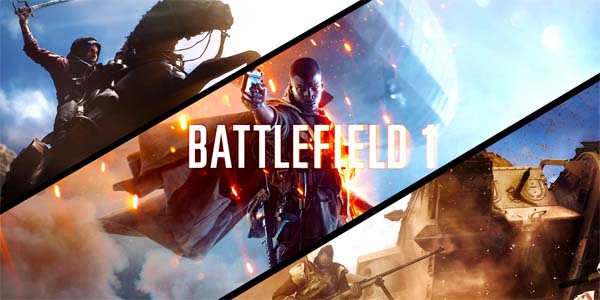
Nobody can make a game about World War I. Trench warfare is too boring. Nothing really happens. There isn't a strong, identifiable villain or good versus evil struggle.
Those are among the many excuses that people made for why all the video games are about World War II, and never about World War I. And then the gaming public and journalists got a glimpse of this:
The teaser trailer for Battlefield 1 was a smash hit.
That teaser trailer was damn good. People were excited. I haven't played a first-person shooter since Call of Duty: World at War, I generally hate online shooters, but even I was excited to try out this game! And other people were hyped about it too.
Now, I never really bought into the idea that World War I was "not video game material". I've long advocated for games to look at all periods of history for inspiration, and World War I is a monumental moment in world history that certainly deserves to be examined by games. The indie market certainly realized this, with games like Valiant Hearts and Verdun. But the big publishers have completely shied away from "The War to End All Wars".
This is a shame. The rapid technological advancements and radically new military tactics that evolved leading up to (and during) the war could be great material to examine in the form of a game. The widescale industrialization of warfare, the complicated politics, and the general fuzziness of the morality of the war are also ripe source material for dramatic storytelling. So it's about time to see this war thrust into the mass market spotlight.
I'd prefer to have seen a strategy game along the lines of Total War; but whatever, I'll give DICE and Battlefield 1 a chance.
UPDATE: 12 MARCH 2018, Better than I gave it credit for:
After having played Activision's Call of Duty: WWII and (especially) EA's Star Wars:
Battlefront II, and having talked about it with friends, I have gained a bit of respect for the successes that Battlefield 1 has been able to accomplish. I've started to like it more in retrospect. Not enough to go back and re-play it or try out any of the expansions (yet), but I do feel that I may have been a bit too harsh on the game in retrospect, especially with regard to its campaign vignettes.
I'm not going to change my original review score, but compared to CoD:WWII and Battlefront II, this game probably deserves a slightly higher grade. So keep that in mind as you read the following review. Of all the big-budget first person shooters that I've played in the past couple years, Battlefield 1
is probably the one that I most enjoyed, and it's the one that I would recommend.
The futile indifference of war
First impressions were actually pretty damned good. I was actually really impressed with Battlefield 1's campaign tutorial. It's basically a guided tour of the game's various core mechanics: shooting at enemy soldiers, capturing victory points, piloting vehicles, and so forth. It does a good job of introducing each of these mechanics and systems by jumping the player around between multiple characters in a large-scale battle.
But what really stuck out to me was how the tutorial transitioned between these different set pieces, and how it handled player death. This tutorial is actually surprisingly merciless and difficult. As you complete one set piece, the game gradually (and subtly) increases the threat until it becomes overwhelming and your character dies (or they just kill you after a timer expires), which allows the game to teleport you to the point of view of another character for the next set piece. The dying character's name and birth / death years are shown on screen during the transition, granting that character with a certain degree of humanization.
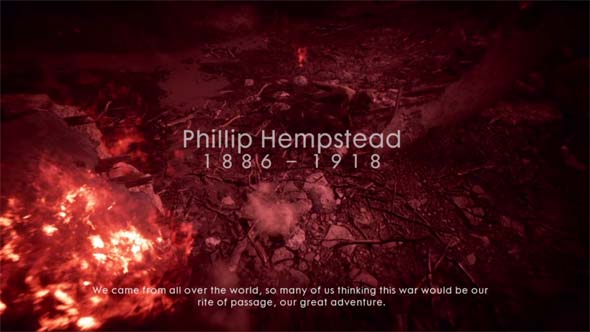
The excellent tutorial emphasizes the indifference and futility of "The War to End All Wars".
Depending on how good you are at the game, you'll go through between half a dozen to a dozen different characters, each with a name and an age. And they all die. The tutorial makes this war look brutal and futile. It even has an almost Dark Souls-like indifference to the player character, killing you without a second thought and forcing you to respawn as another poor, dumb bastard who's about to die for his country, rather than restarting you at a checkpoint until you get it right.
I even wish DICE had gone a bit further by also displaying the character's birth place and maybe even a snippet or two of other biographical trivia. Maybe listing some hobbies, or saying that he was on his high school's varsity football team, or some other little detail like that. DICE settled for just the name and birth / death year, but it's still effective and establishes a very strong running theme throughout the tutorial. The point is a bit undercut by the rapid pacing and by how conventional the actual running and shooting feels. But I still walked out of this tutorial excited by what the rest of the campaign had to offer. [More]
1b3222c5-df25-48fc-8292-199702831456|1|5.0
Tags:Battlefield 1, Battlefield, EA, Electronic Arts, DICE, PC, mouse & keyboard, EA Origin, shooter, online, multiplayer, World War I, war, history, trench warfare, chemical weapon, Harlem Hellfighters, tank, biplane, horse, England, France, Germany, Ottoman Empire, Europe, Argonne Forest, Arabia, Laurence of Arabia, eBay
Back in the summer, my girlfriend and her brother saw that Norwegian Air was offering direct flights from Las Vegas to Copenhagen, Denmark for relatively cheap (under $400 round-trip). So we bought some tickets, made reservations at a hostel in Copenhagen, and spent our Thanksgiving holiday traveling to Europe and getting some more stamps on our passports. This was only my second trip to Europe and the second set of stamps that I got on my passport.
The flight was pretty grueling. Ten hours in economy seating is not the most comfortable thing in the world. The time-zone difference also meant that the flight effectively wiped an entire day off of our calendar. Ah well. We bought a transit card called the "Copenhagen Card", which gave us free use of the public transit systems for the entire week. It also granted us free admission to some public facilities such as castles, museums, and parks. It was a very handy thing to have!

Gløgg is a Scandinavian holiday wine.
Apparently, the Danes really like Christmas. One of the things that struck us almost as soon as we got off the plane is that the entire city was decorated for Christmas. Whole buildings were covered in lights, street lights were lined with garlands, and there were multiple Yule Markets (outdoor gift and food stands) lining the streets and squares of the city. Since the Danes don't have Thanksgiving, they apparently don't have any reservations about putting up Christmas decorations in November. We walked through some of these street vendors and Yule Markets and tried our first Danish delicacy: gløgg. Gløgg is a Swedish and Danish drink that mixes hot mulled wine with cinnamon, ginger, cardamom, raisins, and almonds. It's kind of like a sweet hot tea, and it's a very strong drink with a somewhat overwhelming fragrance. It was good in moderation, but its overwhelming sweetness meant that it wore out its welcome for us very quickly... [More]
5a6382b0-bb40-46ce-8620-3080bbc87496|0|.0
Tags:Copenhagen, Roskilde, Denmark, Malmo, Sweden, Europe, vacation, passport, Norwegian Air, Generator Hostel, hostel, public transit, Thanksgiving, November, Christmas, holiday, glogg, Paper Island, Viking, longship, museum, National Museum of Denmark, Viking Ship Museum, Rosenborg, Kronborg, Malmohus, castle, renaissance, Tivoli Garden, Elsinor, Hamlet, William Shakespeare
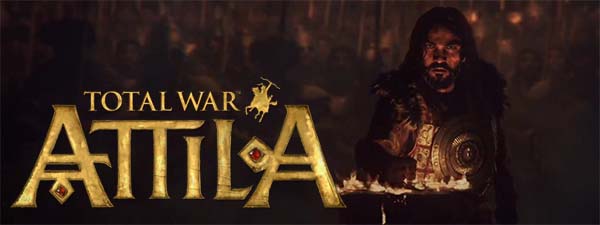
A few months ago, I posted an article outlining some suggestion for unique civilization themes and abilities for a possible Sid Meier's Civilization VI game. In it, I proposed a unique characteristic for the Huns or Mongolians: that they be a true nomadic empire. The idea was that they would have traveling cities that allowed them to move their empire with their army and essentially occupy any unclaimed territory or territory vacated by defeated rivals. Well, the Creative Assembly had already beaten me (and Firaxis) to the punch with Total War: Attila (and apparently Firaxis is embracing the idea with Beyond Earth's first expansion). Total War: Attila has a feature almost identical to what I had conceived for the Huns and Mongolians in Civilization. I'm a fan of the Total War series as is, so I was going to play this game for sure. Of course, Creative Assembly running with an idea that I had independently conceived of only made me more curious to play the game.
Attila acts as sort of a sequel to Rome II. While that game was all about building up the Roman empire (or whichever empire you happened to select), Attila is all about tearing down those empires. But this is a fully stand-alone game (like Napoleon Total War was to Empire Total War), and does not require Rome II in any way.
Learning how to be a horde
The Prologue campaign in this game is brutal! It's like a Demon's Souls tutorial that is designed to kick your ass. I restarted it once before realizing that it was designed for the player to fail in order to teach the new migration feature.
This prologue acts as a tutorial for the new features and mechanics of the game, but it doesn't do a particularly good job of teaching these mechanics. It also doesn't go into much detail of the established features of the franchise (other than telling you that a feature exists, then making you click on the button to do it), so new players might find themselves completely turned off by the fact that they are having their asses handed to them and aren't being taught much about how the game actually works, or - more importantly - why they are failing so hard. Perhaps having two separate tutorial campaigns would have been advisable: one to teach basic Total War concepts of empire and army management; and a second tutorial campaign for experienced Total War players that just teaches the migration features.
The brutal tutorial concludes with the challenging, climactic, historical battle of Adrianople,
in which your Visigoths must hold off Emperor Valens' superior army until your cavalry arrives.
Playing as migratory hordes minimizes city management, but you do still have to develop infrastructure for your nomadic armies. Rebuilding conquered cities and defending your borders, however, is not an issue - which was always the most tedious part of the game anyway. You don't need defensive armies in your territory and are free to focus all your efforts on your eventual goal. This change works well with the requirement that all armies must be attached to generals, and is a big step up from Rome II. There were large chunks of Rome II's campaign in which I felt like I couldn't do anything because I had to camp out my armies in cities in order to replenish and improve public order. Since I was at the army cap, the campaign would stagnate because I couldn't build new armies in order to watch over my newly-conquered settlements while also pressing forward with my primary armies... [More]
da530405-0213-4b1a-93c4-503924d797fd|0|.0
Tags:Total War, Total War: Attila, Creative Assembly, Sega, PC, Steam, Attila, Attila the Hun, Huns, Rome, Western Roman Empire, Eastern Roman Empire, Constantinople, Byzantine Empire, Sassanid Empire, Europe, Goths, Visigoths, Ostragoths, Germanic tribes, Franks, Saxons, Vandals, strategy, turn-based strategy, real-time strategy, grand strategy, history, campaign, horde, migration, climate change, the Great Migration, steppe, Sid Meier's Civilization, war, nomad, siege
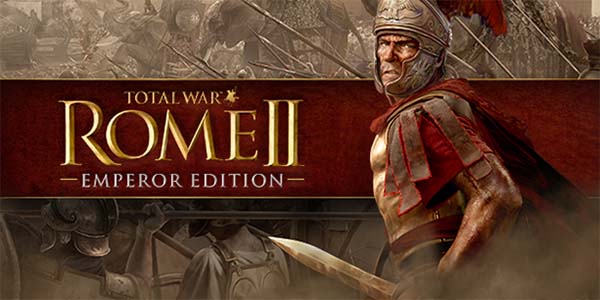
A couple years ago, I wrote an impressions post for Total War: Rome II with a tentative review score of 5 out of 10. I never got around to writing a full review of the game because it remained in a near constant state of flux for over a year after its release. The developers kept adding new DLC ranging from modest culture packs to the tiny Blood & Gore pack. Last year, Creative Assembly released a massive DLC pack that also included across-the-board balance updates and expansion of some of the game's core features. This "Emperor Edition", and its attached Imperator Augustus campaign was free to everyone who bought the original Rome II, and so I decided to give it a try to see if it greatly improved the game.
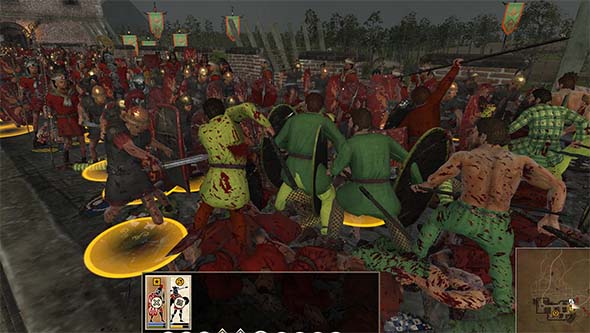
Blood & Gore costs a few dollars extra for those who want it, and increases the ESRB rating to Mature.
Core gameplay has subtle changes
Most of the changes to the core game are subtle, but they do add up to create a more enjoyable experience. The A.I. isn't nearly as bad as it originally was, and naval battles are actually playable now. Building effects have been completely rebalanced in order to avoid the problems with rampant squalor and lack of food that plagued the core game, and the politics systems have been changed to be more active and relevant to the game. Unfortunately, many of these changes are so sweeping, that they break existing campaign save games, meaning that if your version of Rome II was automatically updated, then you lost the ability to continue with any of your previous campaigns.
The most notable changes to empire management is that resources and building upgrades allow for much greater specialization of your various regions. This combined with the rebalancing of squalor and food means that there is incentive to actually upgrade your buildings past the first couple of levels. You also have some more meaningful decisions on what buildings you want to build and upgrade.
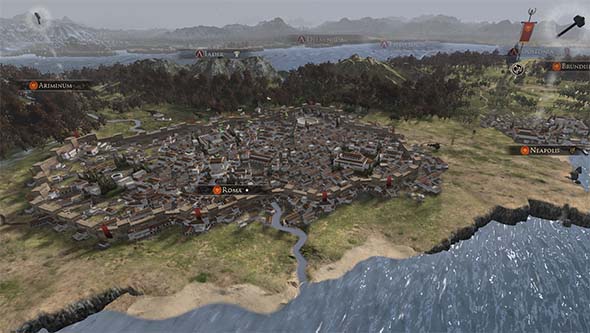
Squalor is no longer an intractable restriction towards building the glory of Rome.
Cities still physically grow on the map as the population grows and more buildings are constructed, and many of the high level buildings can add unique visual flairs to individual cities. It's also informative, since it's easy to see (at a glance) what infrastructure a city might have, which can help you manage your own empire, and can help you to assess the worth of a city for potential conquest.
A.I.s have also been designed to build higher-level settlements and to manage their armies better. Having higher-level buildings means that they have larger armies with more advanced units and better equipment. They provide a much greater challenge, as well as more tempting targets of conquest now. I haven't run into situations in which major factions (Carthage) dissolve into rebellions at the start of the game like I used to see in the base game.
Higher morale means battles last longer
Perhaps the best improvement that's been made by the post-release patches and the Emperor Edition is that the real-time battles are paced much better. Unit morale has been significantly tweaked so that units don't route and flee as soon as they make contact with a superior enemy force. Battles will generally take more than just a couple of minutes to complete, but they still aren't anywhere close to occupying the entire hour that the battle timer allows.
You'll actually have time to move some support units to help out an outnumbered defender before they flee, so there's also a lot more strategy involved in the individual battles. Reserve forces and cavalry flanking maneuvers have more relevance, and generals actually have time to reach front-line units in order to use their powers. You don't have to just clump all your units together in a single wall and ram them into your opponent anymore. You can even engage the enemy with a smaller force if you are stuck having to wait for reinforcements to arrive.
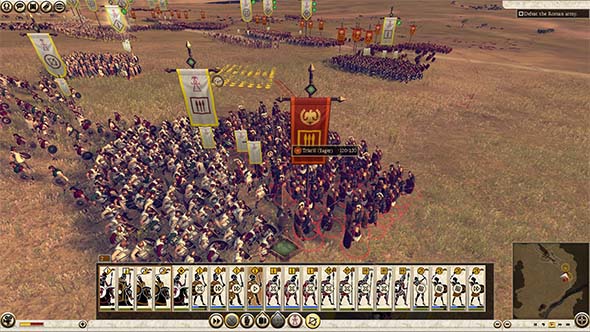
Tactical battles are slower, making cavalry and reserves more relevant, and allowing for more strategic thinking.
Speaking of cavalry, they are actually useful now, since units are generally more responsive to movement commands. In the initial launch version, I found cavalry to be useless because once they engaged an enemy unit, it was almost impossible to disengage without the whole unit getting routed or wiped out. Basically the only thing they were useful for was chasing down enemy skirmishers or flanking artillery. Now, I actually build and use cavalry because they are useful for hit-and-run attacks against regular melee infantry. You still want to keep them away from the pointy end of spears and pikes, but that's to be expected.
I still wish the battles were slowed down a little bit more, but the pacing is a lot better than it was at release. I still rarely see battles last more than 5 minutes of actual fighting, and I still routinely have to pause the game in order to issue orders because unit movement and combat happens so fast ... [More]
457b05a7-62ac-45d9-a1b0-5c8730e665e3|0|.0
Tags:Total War, Total War: Rome II, Rome: Total War, Creative Assembly, Sega, PC, Steam, Europe, Rome, Roman Empire, strategy, grand strategy, real-time stratey, turn-based strategy, history, campaign, war, siege
|

| 12 | | | | | | | 60 | | 11 | | | | | | | 55 | | 10 | | | | | | | 50 | | 09 | | | | | | | 45 | | 08 | | | | | | | 40 | | 07 | | | | | | | 35 | | 06 | | | | | | | 30 | | 05 | | | | | | | 25 | | 04 | | | | | | | 20 | | 03 | | | | | | | 15 | | 02 | | | | | | | 10 | | 01 | | | | | | | 05 |
|